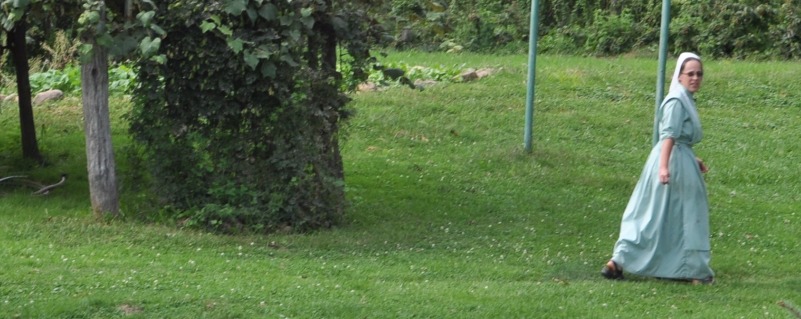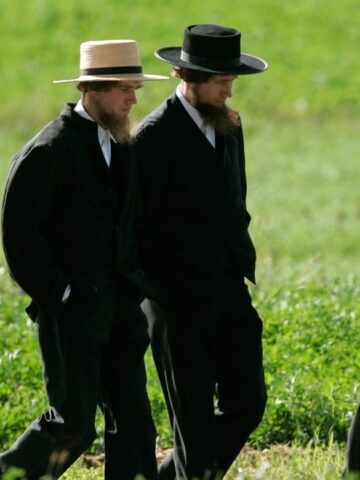By Kevin Williams
There are Amish, Mennonite, and Brethren communities all over the USA and Canada, but there are also settlements that are "Plain" and not affiliated directly with any of the just mentioned churches. These "para-Amish" communities as some researchers call them are quite interesting, often blending some strands of multiple faiths. Some Amish churches incorporate elements of Hutterite or Mennonite theology into their churches, but others are too far off the theological grid to call them Amish or Mennonite. These off the grid ones are ones I'd most like to visit and hopefully will in the years ahead..
Here are the ones topping my list:
CORINNA, MAINE - I have heard that there is a Plain community here and that it is a place where Amish who have gone wayward elsewhere can go to live plainly and start fresh. But, as far as I know, it's not an Amish community. It's just a Plain settlement. I spoke on the phone once to a minister in that church, but it was years ago and I wish I had asked him more questions about his church.
LIBBY, MONTANA: From my understanding, Libby is a settlement of ex-Amish. I actually went right through the town of Libby about six years ago, but time kept me from exploring the area. Too bad, because I doubt I'll make it that way again. Here is a website for an "Amish community church" in Libby....the church split from the more traditional Kootenai Amish settlement about an hour north. The Libby church. The site describes the church, in part:
Libby Amish Community is a spirit-filled Amish church that has opened its doors to the body of Christ who are hungering for a family oriented church and community lifestyle. As a community that walks together and works together daily it offers many opportunities to both help each other and grow in an environment that requires greater transparency. Community and church are inter-related to the point that the opportunity to connect and fellowship can happen quite spontaneously.
The church/ ministry grounds are on a centralized 20 acre parcel of land where the meadow meets the mountain. The community is 10 miles south of Libby, Montana off of US Highway 2, on Farm to Market Road. Although the mountains are all around us the main body of land is a large open meadow in the midst of heavily forested federal and state lands. Families live around the perimeter of the meadow while others live on the mountain or in nearby outlying areas.
CANEYVILLE, KENTUCKY: This is a "Christian community", the last remnant of a concept pushed by late Amish leader Elmo Stoll. He was trying to create a communal church which blended some ideas from the Hutterites, Mennonites, and Amish. Church members in Caneyville dress plainly, use horse and buggies, but live in a more communal setting. They are also more accepting of photography.

Lobelville Amish woman Mary Nissley in Knox County, Ohio. Dress is similar to the Amish,but with some differences...
LOBELVILLE, TENNESSEE: Some people refer to this group as the "Lobelville Amish." They dress plainly, but they do drive cars. They also espouse more evangelism than other more traditional Amish churches. I've met Lobelville Amish in Pearisburg, Virginia and in Knox County, Ohio, but I've never been to Lobelville, Tennessee.
MUDDY POND, TENNESSEE: This central Tennessee settlement is a "Mennonite mish-mash" of Plainly dressed members of the faith,but they are drawn from Swiss Amish communities, traditional Amish settlements and seekers.
A brief description
Follow a narrow winding road up a steep hill through five or six sharp curves, turn left at the Mennonite church, and you’ll be on Muddy Pond Road. Continue up its twists and turns past a few fields of sorghum cane, some arrows pointing the way to the Muddy Pond General Store and even a sign offering black buggy beer. You’ve found Muddy Pond.
Why is it called “Muddy Pond”?
Muddy Pond is actually named after one of the many small muddy ponds up on this mountain community. Now it’s home to several Mennonite communities as well as lots of small local farms.





Judi Covey
You reminded me with this article --- I grew up in eastern South Dakota. We had people that my mother told us were the "Russian Colony". The ladies wore white bonnets and black dresses. Do you know who these people really were? Were they Amish or Mennonite or ??? I haven't thought of them in years until I read your article. We left South Dakota when I was 15.
Kevin
Hi, Judi - Welcome to amish365! Those were Russian colony (not sure why the "colony" is there, they didn't really live in colonies) Mennonites, there is still a Russian Mennonite presence in the Dakotas...Kevin
Judi Covey
Thank you - great memories!
Anne
Kevin, you should visit Muddy Pond and Allen County Kentucky as well. I live just north of Nashville and make regular visits to Allen County to shop at the two Amish stores there and also to buy veggies from the farmers. I've also been to Muddy Pond. The people from both places are awesome
Kevin
Thanks, Anne, I would love to visit both of those places, they are on my list!
Sister Su
I highly recommend visiting Caneyville. Here is a little background info for those who don't know:
https://en.wikipedia.org/wiki/Caneyville_Christian_Community
For those who can't go, or until you are able, try their bi-monthly magazine Plain Things. It costs $12/year.
For subscriptions, write: Plain Things, 1000 Choncie Lee, Caneyville KY 42721.
Blessings!
Kevin
Sister Su, thank you so much for this. I'll send away for their magazine! I'd love to visit sometime, do you live there?